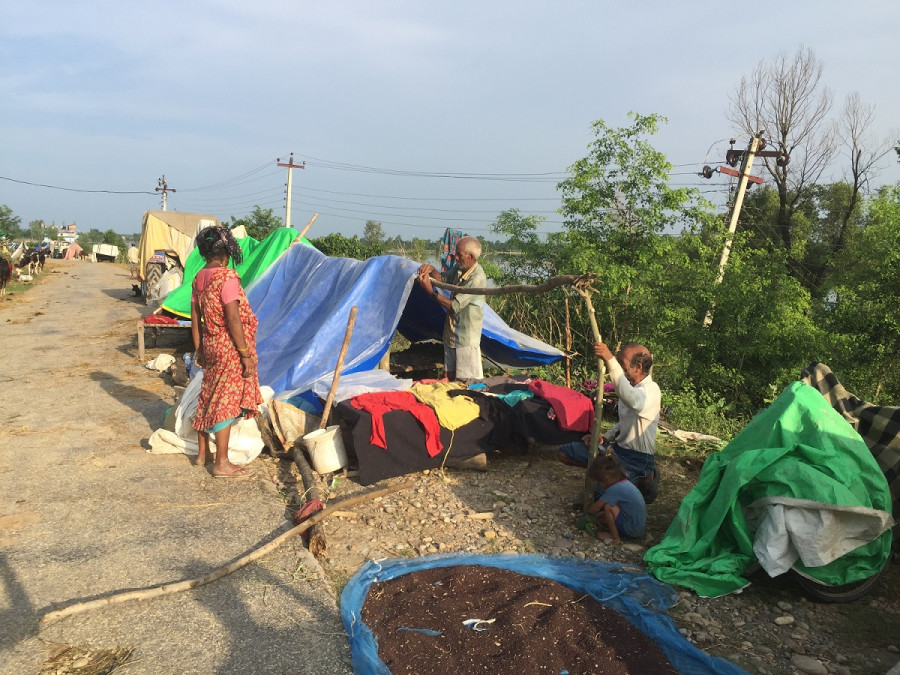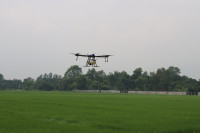Sudurpaschim Province
Flood-displaced families in Kailali living by the roadside
Almost a week into the disaster, more than 200 families from Bhajani have pitched tents along the Postal Highway awaiting relief and safe return to their homes.
Mohan Budhaair
On Saturday morning, Nirmala Shahi was cooking a meal for her family of four on a stove she had salvaged from her flooded house in Krishnanagar in Bhajani Municipality, Kailali. The family has pitched a tent on the side of the Postal Highway after escaping from their flooded settlement four days ago.
“Our house is still waterlogged. My husband waded through waist-high water to see if there were any food grains left in the house,” said Shahi. “He found a wet sack of rice and brought it here. I let it dry out in the sun yesterday and that’s what I’m cooking today for us to eat.”
Krishnanagar in Bhajani had been experiencing heavy rainfall since Tuesday night, causing the Pathariya and Kanda rivers to burst their embankments and flooding Krishnanagar.
“The villagers managed to save themselves since the floodwaters entered the settlement during the day. Around 250 families fled to the Postal Highway to save their lives but they could not salvage food, clothes and other belongings,” said Buddhiram Chaudhary, a tractor driver, who is also currently taking shelter on the Postal Highway with his seven family members. “I had parked my tractor by the roadside on the highway. I took my children with me when the water level began rising in the settlement and kept them in the tractor,” he said. “It’s been almost a week since we’ve been living in the tractor now.”
By Saturday, more than 200 families had reached the safety of the Postal Highway after fleeing their submerged homes.
Nandaraj Dhungana’s house has been rendered uninhabitable by the flood.
He has erected a tent next to the Shahis.
Dhungana, who is in his mid-fifties, said he has been surviving on noodles and beaten rice since Wednesday. “I haven’t eaten a warm meal for days. People from the ward office came to visit us only today, four days after the disaster, and gave us tarpaulin, a bucket and some dry food.”
Chhaya Devkota, deputy mayor of the municipality, said the ward officials could not immediately reach out to the flood-displaced people because they were busy with rescue works.
“We were still helping the people move from the flood. There were families stuck who got caught in the flood and couldn’t leave their homes,” she said. “We have managed to evacuate everybody out of their homes. We will now focus on relief works.”
According to Devkota, the municipal office plans to run emergency relief work for 10 days before starting the next phase of relief work to help the flood-displaced families with food and accommodation for at least one month. “The displaced people need food, clothes, kitchen utensils, clean drinking water, among other essential materials, for at least a month. We are making arrangements to provide them with everything they need,” she said.
Among the displaced are new mothers and their babies who need the most attention right now.
Anjali BK escaped the flood with her five-month-old baby. She and her baby have been spending their nights in her husband’s auto rickshaw for the past four days.
“Mosquito bites have caused rashes all over my baby’s body. I haven’t even been able to breastfeed him and there is no milk anywhere,” said BK. “There is also the fear of snakes, particularly during nights.”
With the rainfall subsiding from Saturday, the water levels in Pathariya, Kanda, Kandra and Mohana rivers are slowly receding. Some of the displaced families have returned home to salvage their properties and their belongings, but many families from Ward No 3, 5, 7 and 8 of the municipality are still living on the Postal Highway as their homes remain waterlogged.
According to Devkota, the deputy mayor, 2,415 houses in all nine wards of Bhajani have been affected by the flood. “A total of 1,671 families have been displaced. They have been taking shelter on the Postal Highway, local school buildings and other places,” she said.
Floods and inundation are recurring problems in the settlements that lie close to the Postal Highway. The area also has many rivers winding through its various settlements. “But the main reason for yearly inundation in the area is the highway itself. The highway was constructed some eight years ago by raising the level of the land so that it lies at a higher elevation,” said Gauri Shankar Chaudhary, a member of federal parliament representing the area. “The highway lacks a proper drainage system and whenever there is rainfall, the water drains down to the settlements.”
The locals living in the area believe that it’s not just the Postal Highway that leads to yearly floods. They say the Kailaspuri dam built on the Karnali river near the Nepal-India border on the Indian side has also exacerbated the flooding problem in their settlements. The dam stops the rain-swollen river from flowing southward causing inundation in settlements that lie upstream, they say.
“But there are other factors too that contribute to this disaster every year. There is haphazard excavation of riverbed materials in the rivers and streams which messes with the systematic flow of the rivers; human encroachment of riversides cuts into the riverbeds and there’s major deforestation which has left the slopes and hills barren,” said Bijaya Shrestha, a local conservationist. “The rivers in this area were around 200 metres wide some 20 years ago. Now they are hardly 20 metres wide.”
According to him, around 400 big and small rivers and rivulets cause inundation in various places of Kailali every year.
Bhajani, Tikapur, Janaki and Joshipur local units lie at a lower altitude and are the most affected by floods and inundation. The locals have urged the government authorities to take initiative to control the floods and inundation but no concrete steps have been taken so far.
Prakash Shah, minister for internal affairs of Sudurpaschim Province, who was on an inspection of the flood-hit areas on Saturday assured the locals that the provincial government will come up with a plan to control the rivers and stop the damage they have been causing to settlements every year. “We will hold talks with the stakeholders to manage the water outlet system before the ongoing highway upgradation project completes,” said Sah.




 16.2°C Kathmandu
16.2°C Kathmandu













